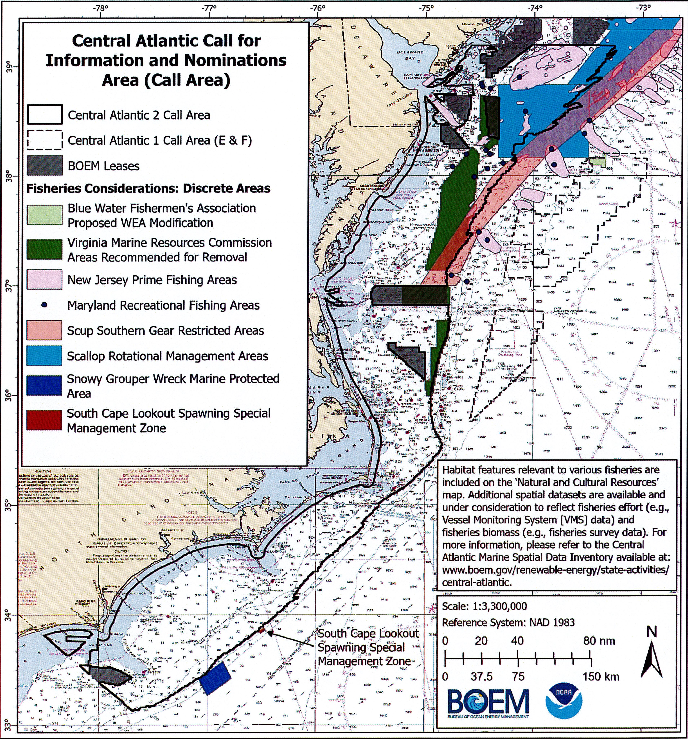October 23, 2024 — The following was released by the Port of New Bedford:
The New Bedford Port Authority (NBPA) has submitted a formal response to the Bureau of Ocean Energy Management (BOEM) regarding the recently proposed Central Atlantic 2 Call Area (Docket No. BOEM-2024-0040), raising significant concerns about its potential impact on the commercial fishing industry. As the nation’s most profitable fishing port and home to the first large-scale offshore wind marshaling port, New Bedford is deeply invested in both renewable energy development and the preservation of vital fishing grounds.
“BOEM has painted with too broad a brush. As the port where the fishing and offshore wind industry intersect more than anywhere else, New Bedford is committed to the successful coexistence of both industries. We believe that the new Mid-Atlantic call areas must be cut back from existing scallop and other fishery access areas, which still would leave ample room for nearby states to achieve their offshore wind capacity goals,” said New Bedford Mayor Jon Mitchell.
While the NBPA supports offshore wind development, it emphasized the importance of balancing this growth with the protection of established industries. In particular, the letter calls attention to the critical scallop fishing areas-Elephant Trunk, Hudson Canyon, and Delmarva-that fall within the boundaries of the proposed Central Atlantic 2 Call Area. The National Marine Fisheries Service (NMFS) estimated the 16-year catch value for the most impacted commercial fisheries in the area of the proposed call is just under $2 billion, with just under $1.5 billion of that amount coming from sea scallops.
“Our grave concern about this CA2 call area is that it unnecessarily includes some of the most critically important scallop fishing areas on the East Coast,” wrote Gordon Carr, NBPA Executive Director. “What is stunning to us is that all that data is and was available to BOEM prior to setting the boundaries of the proposed call area.”

Mr. Carr noted that the call area “could have been set approximately 150 miles to the south, avoiding these critical scallop grounds, while still leaving more than 400 miles and millions of acres of call area down to the South Carolina state line.”
The Port of New Bedford has long been involved in offshore wind planning, providing comments on multiple projects in the region. The NBPA emphasized that “development must only be accomplished in a responsible manner by protecting established industries that share our waters. In particular, ‘responsible manner’ must include learning from mistakes made in failing to avoid and address the interaction and conflicts between offshore wind and commercial fishing in connection with previous BOEM actions.”
“It is long past time for BOEM to take seriously its responsibility towards the other users of the Outer Continental Shelf (“OCS”), some of which, like commercial fishing, have been using the same areas for hundreds of years. BOEM must begin to demonstrate a concerted effort to avoid and minimize the potential impact of a call area, collective lease areas, WEA, and each turbine,” Mr. Carr wrote. “This effort must take place before the potential impact is felt and must be based on more substantive scientific data and information than a hunch. People’s livelihoods are based on these actions.”
The New Bedford Port Authority calls on BOEM to take the concerns of the commercial fishing industry seriously and work toward a more responsible and consistent approach to offshore wind development, one that properly balances the needs of renewable energy with the long-standing commercial fishing industry. BOEM now has the opportunity to scale back the proposed Central Atlantic 2 Call Area to avoid and minimize the effects this area will have on most notably sea scallop, surfclam, and ocean quahog sustainability.
About the New Bedford Port Authority
The New Bedford Port Authority is a state-created agency charged with managing the Port of New Bedford. The Port is the physical center and primary economic engine of Southeastern Massachusetts. It is America’s top commercial fishing port, the staging site for America’s first industrial-scale offshore wind project, and home to hundreds of recreational and commercial vessels and businesses.
For media inquiries, please contact:
John Regan
Director of Policy & External Affairs
John.regan@newbedford-ma.gov
(508) 961-3000
